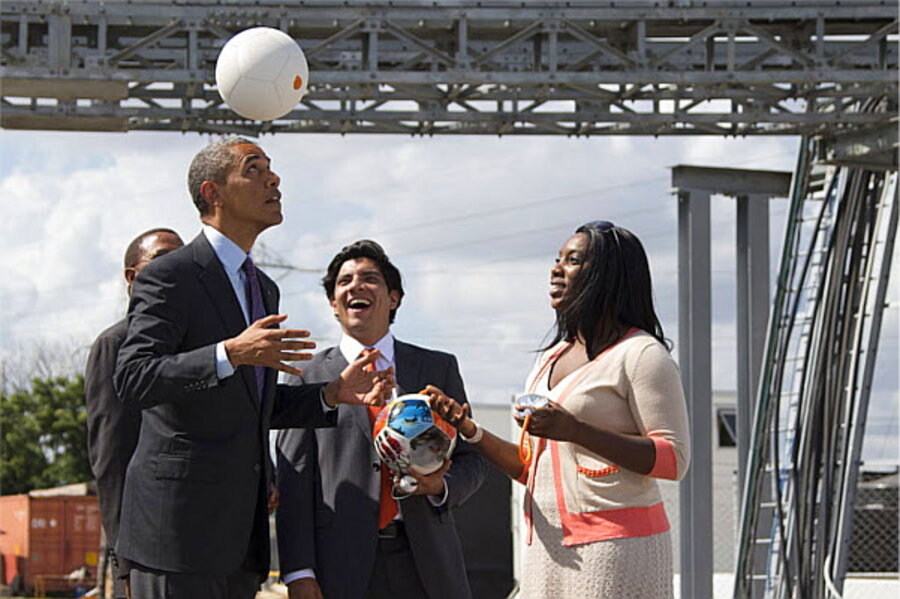Obama's big Africa push: Let there be light
Loading...
The centerpiece of President Obama’s eight-day visit to Africa was a $7 billion US initiative to increase electricity and bring new power sources to sub-Saharan Africa, where in some rural areas only 10 percent of families can turn on a light.
Obama said the plan, which joins with US giant General Electric, will “double” the amount of power available in targeted areas of Kenya, Liberia, Tanzania, Ghana, Nigeria, and Ethiopia – states that will divvy up the $7 billion.
Obama linked greater power to the improving prospects of an African middle class by saying that, “it’s the connection needed to plug Africa into the grid of the global economy.”
Former US ambassador to Nigeria John Campbell said that the White House push addresses a “major, major issue" since "the absence of electrical power … makes it difficult to establish the kind of manufacturing that generates employment.”
Yet the US president also called access to “the light that children study by” a form of liberation. Speaking shortly after meeting the family of Nelson Mandela, the anti-apartheid icon who spent 27 years in South African prisons, Obama said: “Just as freedom cannot exist when people are imprisoned for political views … true opportunity cannot exist when people are imprisoned by sickness, or hunger, or darkness.”
The “Power Africa” plan comes as the White House says it wants to “up its game” in Africa at a time when China has been investing heavily.
Yet the electrification plan, which mixes US funds with a planned $9 billion in private corporate dollars, is also being described by the White House as a new model for US aid abroad. Yet some analysts wonder if Congress will provide funding during an era of sequestration.
The details of the plan:
- While $7 billion for African power plants and grids may sound large, the White House cites the International Energy Agency saying the cost to bring normal electricity to sub-Saharan Africa by the year 2030 is a whopping $300 billion.
- In the old aid model, such as the Bush administration's HIV program for Africa, US taxpayer dollars were distributed directly, often through the US Agency for International Development. But in the Obama plan, only $285 million of the $7 billion will move directly through USAID.
- It is not yet clear beyond about $300 million what exactly the US Treasury will fund. The White House tally of the $7 billion surpasses that mark with funding from other sources, with the US Export-Import Bank to provide $5 billion, the Overseas Private Investment Corporation to give $1.5 billion, and the Millenium Development Corporation to offer $1 billion. Yet these are mostly likely loan guarantees where, say, if Tanzania wishes to purchase turbines worth $50 million, the US-based funds guarantee the loan.
- Former Ambassador Campbell says it remains unclear exactly how much federal money is involved, but doubts that in an era of sequestration and military base closing the White House will be able to secure funding from Congress.
- The plan aims to create 10,000 megawatts of power, of which General Electric “commits to” 5,000 megawatts through technology and expertise in Tanzania and Ghana according to the White House. Forbes today notes that, “In late June G.E. signed a tentative deal with government of Ghana to build a 1,000 MW power plant. This plant would likely be fueled with natural gas sourced from the Jubilee offshore field, a multi-billion-dollar project, in which Texas-based Anadarko Petroleum has a large stake.”
- Reuters reports that “Outspoken American real estate mogul Donald Trump called Obama's Power Africa plan 'crazy,' saying Mr. Trump tweeted that, 'Every penny of the $7 billion going to Africa as per Obama will be stolen - corruption is rampant! ... We should be concerned about the American worker & invest here.'"
- Nigeria, Ethiopia, and Kenya make up nearly half of sub-Saharan Africa. Nigeria's population alone is more than 174 million.






